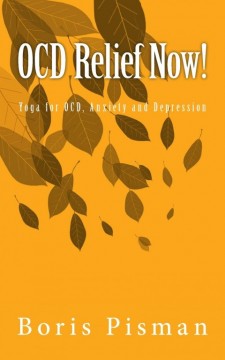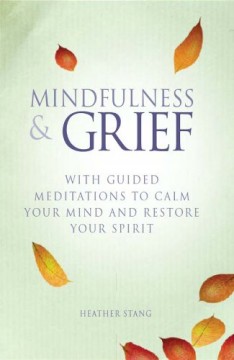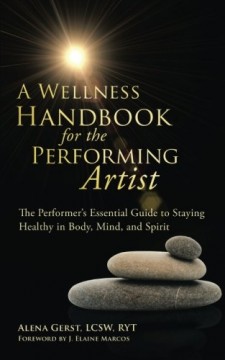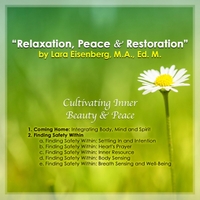
Ahhhhhh! Here we are, summer at last. No research this time. Just a couple of book recommendations as you settle into the hammock. If you’re feeling stressed, despite the good weather, make time for leisure every day, even if you’re not on vacation. How about a few minutes for a pranayama breathing practice outside, or an outdoor concert, or a walk with a friend? Pause to appreciate the feeling of sunlight on your shoulders, the sight of your world a little greener than it was a week ago, the taste of the fresh produce you bought at your local farmer’s market, the scent of jasmine or roses on your morning walk, or the sound of music on the green, or the beach or in your own backyard. As the to-do list shrinks, you might wish to catch up on a new novel (my favorite this year was Goldfinch by Donna Tart), or one of the books we’ve reviewed here—how yoga can help OCD, how it can support you through a time of grief, and how it can offset the stress of being a performing artist. I hope to see you at Kripalu this summer, or at the Cape Cod Institute, or up in Canada!
Review: OCD Relief Now: Yoga for OCD, Anxiety & Depression by Boris Pisman
Boris Pisman is an experienced psychotherapist and yoga and meditation teacher, who writes a user-friendly manual of self-observing exercises that may lead to a greater awareness and therefore a dis-identification with obsessive thoughts. He offers three basic techniques: 1} a body scan relaxation exercise 2) basic instruction in deep belly breathing and 3) a simple thought-observing meditation that does not rely on concentration, but rather on an open-focused awareness of thoughts. In short separate chapters, Pisman moves through ten categories of OCD—from hoarding to sexual obsession to health anxiety and discusses panic attacks and depression related to obsessive thinking. He briefly introduces a clinical example, then discusses the thoughts common to those who suffer from that variation of OCD. His message is the same for each category: Your obsessive thoughts are not unique to you, and given your condition, your thoughts make sense. His recommendation is to stay in awareness of your thoughts, neither engaging them, nor trying to eliminate them. He recognizes that anxiety will arise as you change the way you relate to your obsessive thoughts and suggests giving space to the anxious feelings.
This is a non-judging approach to working with all kinds of negative thoughts that often cause feelings of shame and harsh inner-criticism in the thinker. Pisman understands that and encourages those suffering from OCD to accept that they have a condition that makes them think in certain ways, and to not judge themselves for their thoughts. It may be inspiring to read such a book that can normalize thoughts that intrude, once one has an understanding of one’s particular form of OCD. For this reason, I would recommend OCD Relief Now.
However, there are many other yoga-based strategies that we have found helpful for those suffering from OCD. For some, the act of simply watching the thoughts can make symptoms worse. There are a range of mudras, mantras and pranayama breathing exercises that can provide relief by anchoring the mind in the moment, and, over time, reducing intrusive thoughts throughout the day. For example, after the daily practice of the LIfeForce Yoga Chakra Clearing Meditation, a LifeForce Yoga Practitioner who herself suffers from “checking” OCD, no longer has to spend ten minutes pulling back and forth in her driveway, worried about what she didn’t turn off, or what she might have forgotten to pack for her day of teaching. Another LFYP, a psychologist specializing in OCD, finds great relief in the practice of brahmari bee breath. While the message of acceptance is important, I think this book would have benefited from a broader range of practices to address the overly-active and anxious mind of some people who suffer from OCD and cannot tolerate this open-focused, awareness form of meditation.
Again, if you suffer from OCD, reading about your own condition may go a long way towards reducing shame and increasing your sense of self-acceptance. I would suggest reading this book, and if the practices suggested aren’t sufficient to relieve your suffering, move on to other practices.
Review: Yoga for Grief Relief by Antonio Sausys, Foreward by Lyn Prasant
Grief that is unexpressed, denied, avoided, does not disappear. As the author of this passionate, personal and universally applicable book knows firsthand, when we deny grief, it shows up “with pristine clarity” in the body. Out of author Antonio Sausy’s own journey through grief, supported by grief counselor Lyn Prashant who inspired him to create a yoga practice to address the ways grief was showing up in his body, he developed a holistic practice called “Yoga for Grief Relief.” This practice, along with Sausy’s training as a psychotherapist, his understanding of neuroscience and his training as a yoga therapist form the basis of this excellent and easy-to-read and follow book.
In the first chapter of Yoga for Grief Relief, Sausys takes us through the current psychological understanding of grief and the mourning process. He provides a map for mourners and for those of us who love and serve them that includes the stages of grief and clear charts that illustrate the physical emotional and behavioral symptoms of grief. The section on the malleability of the brain and its ability to change gives the reader hope that the practices he will introduce can not only stem the tide of grief, but can actually change the brain’s anatomy.
This is not just a set of practices. Sausys doesn’t back away from yoga philosophy and the foundational approach yoga provides for our understanding of human suffering. Rather than complicate the picture, his section on yoga philosophy clarifies our relationship to grief, primarily by sorting out the yoga view of attachment from the Western view of attachment theory. Sausys includes a clear discussion of the Chakra system, which he offers as a diagnostic tool—our physical symptoms in the grieving process could indicate areas in the body mind where our energy is blocked by grief.
Before he dives into the practices themselves, Sausys gives us an overview of the sadhana he developed that includes breathing practices (pranayama), postures (asanas), emotional release techniques (sharkarma), self-relaxation, intention-setting (sankalpa), and meditation. He encourages the reader to establish a regular practice and addresses the barriers to doing just that.
The practices are simple and easy to do, and, as they start in a supine position, you can even begin them in bed. There are a number of joint warm-ups that gently get the body moving and the energy flowing. The core of the physical practice is called the Windmill, and Sausy encourages sound, that, when combined with movement can provide both a physical, emotional and energetic release of repressed feeling. There are clear instructions with pictures for breathing practice, gazing practice, relaxation, intention setting and meditation.
Sausys discusses the obstacles to practice and provides suggestions for overcoming them in a section called, “Designing the Logistical Aspects of Your Practice.” He looks at the common questions you may have, like where and when to practice; the benefits of working with a yoga professional, or working alone with a DVD, or in a group setting or one-on-one.
The final section walks us through yoga-based self-inquiry that can help the reader re-establish a firm sense of identity beyond the significant loss. This is as important, in my opinion, as the mat based practices, because it is here that we begin to differentiate and integrate the deeper lessons of yoga—who we are beneath our stories, beneath our grief, beneath our attachments. As we begin to perceive the difference between love and attachment, we open to connect in meaningful ways with others that can keep love flowing in our lives. That flow is made possible by clearing the constrictions in the physical and emotional bodies through the Yoga for Grief Relief sadhana described in this book.
Review: Mindfulness & Grief: with Guided Meditations to Calm Your Mind and Restore Your Spirit by Heather Stang
Reviewed by Rose Kress, ERYT-500, LFYP-2, LFY Educator. Rose is certified in Hatha Yoga at the 500-hour level, has undergone training in Yoga therapy, and is a LifeForce Yoga Practitioner Level 2, Mentor and Educator. Rose teaches LifeForce Yoga classes, private sessions, and workshops throughout the Tucson area and has been blessed to teach classes at The Crossings in Austin, TX, Kripalu in Lenox, MA, and Sivananda Ashram in The Bahamas with Amy Weintraub. She has also taught LifeForce Yoga classes at several Yoga conferences in the state of Arizona. Rose is the Program & Education Director of the LifeForce Yoga Healing Institute and regularly assists Amy at both the Level 1 and Level 2 LifeForce Yoga Practitioner Trainings.
In Mindfulness & Grief, Stang presents an 8-week program for approaching your grief mindfully. This program teaches the reader how mindfulness-based techniques can ease physical symptoms of grief, calm the mind and support regulation of emotions, increase present moment awareness and compassion towards yourself and others, help the reader to make meaning from loss, and develop a new “self-narrative for moving forward.” Stang shares that grief is not an illness, but a “natural part of life that causes us to experience suffering.” Mindfulness practices help us to ease and sometimes eliminate suffering.
Each chapter, or week, in Mindfulness & Grief introduces a new theme, meditation and journaling exercises. There is even a Daylong Retreat included between weeks four and five. The reader is encouraged to set aside 20 to 90 minutes each day for practice and to be gentle with oneself, as there is no right or wrong way to practice. Stang uses Buddhist psychology as the basis for mindfulness. Readers are given a brief history of the Buddha’s life and the Four Noble truths, but the reader is assured that all faiths are welcome as mindfulness is not a spiritual or religious practice. Stang spends time laying the foundation for the practice of mindfulness with preparing a space for practice, how to sit, and setting up a journal. Each week includes a story from a student who has experienced the 8-week program. The chapters are filled with practices, like three-part breath, becoming aware of the senses, breath meditation, relaxation techniques, loving-kindness meditations, to name a few examples.
Mindfulness & Grief is about more than just developing a meditation practice. Stang spends time supporting the reader through reframing the experience of loss and suffering. The first five chapters focus on establishing the practice of mindfulness, while paying attention to the needs of the grieving individual. The following chapters focus on transforming barriers, the process of making sense of loss and “rewriting your post-loss narrative.” For example, week seven is titled ‘Allowing Transformation: Who Am I Now?’ The focus on this chapter is supporting the practitioner through the change that happens as a result of loss, practice and the passage of time. Stang points out that it is not expected that you will have adapted to your loss by week seven, but “it is helpful to understand what you can expect from the grieving process as you continue.”
Perfect for the beginner, Stang offers instruction that is easy to follow and understand. This book is also appropriate for the experienced mindfulness practitioner as it provides a framework around using your established practice to work with grief and loss. It can be easy to drop practices that support us when we are experiencing loss and stress and Mndfulness & Grief gives an opportunity to re-enter practice at a slow pace. No matter your experience with meditation and/or mindfulness, Stang does a wonderful job of normalizing and supporting the grieving process. This is a great read for anyone, as we all experience loss in our lives.
Review: A Wellness Handbook for the Performing Artist by Alena Gerst
Reviewed by Linda Mackay. Linda was a professional actor for 15 years and too, changed direction in her career and is a clinical social worker. She discovered the seamless transference of skills as both professions work to illuminate and find true nature through the examination and exploration of the human potential. Linda has a long time yoga and meditation practice which led her to completing certification in LifeForce Yoga® Practitioner, level 2. She works at the University of Waterloo with students, staff and faculty as well as in private practice at The Space Within, in Stratford, Ontario Canada.
In Alena Gerst’s new book, A Wellness Handbook for the Performing Artist: The Performers Guide to Staying Healthy in Body, Mind, and Spirit, she reflects on her own journey as a professional performer – a triple threat: singer/dancer/actor, and acknowledges that “how the way (she) was living was unsustainable”. Alena draws on her own as well as other artists’ realizations, of the exceptional demands of living the life of a performer, on and off the stage.
Alena, is now a Licensed Clinical Social Worker, a Registered Yoga Therapist, and a LifeForce Yoga Practitioner, working in both private practice and within the New York State Hospital system. She offers the insight of experience, supported by well-researched holistic health and wellness wisdom, and an in-depth training in therapeutic yoga.
The appeal of A Wellness Handbook for the Performing Artist is that it not only gives specific examples of the challenges of being a performing artist, such as constant rejection, financial insecurity and the physical and emotional exertion of the work, but it offers concrete guidance to help a performer create a healthy balance over the lifetime of a career.
Despite having intense training in voice and movement, awareness of breath, focusing on strength and flexibility of muscle and tissue, performers are, at times, sorely lacking in awareness and education of health. The instabilities of the profession, in and of themselves, create barriers to healthy living. Given that many performers begin training and enter their professions at a young age, they are as vulnerable to beliefs of invincibility as any other sample of young people. I work at a university and see first-hand how this plays out in regards to the health and wellness of the average university student.
A Wellness Handbook for the Performing Artist provides performers at any age, a bridge to change. Alena includes brief overviews of the science behind the importance of the sometimes overlooked basics: good nutrition, sleep, healthy care of the body and emphasizes the importance of rest and recovery time.
The repetitive nature of the use of the body as a performer, whether it is the actor bearing the weight of a heavy costume or drawing a sword from the belt 30 times a day in rehearsal or in 8 consecutive shows a week; or the musician practicing several hours a day, with neck crooked into violin; or the dancer sustaining long sequences requiring strength and precision, landing her body again and again and again… makes injury inevitable. Ideally, performers readily utilize chiropractic, massage, physiotherapy and acupuncture and Alena stresses the importance of educating the health care providers in their circle of care about their professional demands. The Stratford Festival of Canada, that has a repertory company of over 120 actors, singers and dancers, actively recruits a host of medical and holistic practitioners who have an experienced understanding and training in treating the whole performer, much like professional athletes do. Sadly, outside of these unique companies, the often underemployed performer, may have little access to such expert and essential health care.
The rigors and competitiveness of a performing career, can cultivate a disciplined and committed work ethic. The other side of this coin, is the performer’s inability to respond compassionately to their own needs and limits. This not only increases the risk of physical injury but of emotional instability. Alena addresses the still rampant stigma of mental health challenges of depression and anxiety and the signs and symptoms to monitor. She refers to the performer’s vulnerability to stage fright and low self-esteem, where perfectionistic standards are the conditions of self-worth. She wisely advises that timely medical assessment, appropriate treatment and counseling, as well as healthy relational supports, are essential in protecting and preventing mental health illnesses.
Alena acknowledges the teachers who have illuminated her path to a fulfilling second career as a mental health and wellness professional. As she has been guided to bring balance to body, mind and spirit, so she now guides others. Performers of all ages will recognize themselves in this book and be inspired to take action, to dare to do things differently. Alena reminds us that the biggest lessons of all, which are inherently cultivated in the practices of yoga, meditation and other healing arts, are love, compassion, and permission to bring the vast breadth of our humanness into harmony. This is a manual for healthy living, whether or not you live the intense life of a performing artist.
MEDIA MENTION: Body Mind Restoration: Relaxation, Peace and Restoration by Lara Eisenberg, M.A. Ed.M. CD
LFYP Lara Eisenberg as released a yoga nidra cd. She leads the practice of Integrative Restoration as taught by Richard Miller. The track Coming Home is the practice of iRest and integrates the body, mind and spirit. Finding Safety Within offers intention setting, heart’s prayer, inner resource work, body sensing, and breath sensing and well-being. This is another wonderful addition to your Yoga Nidra library. To order and for more information: www.mybodymindwellness.com.
